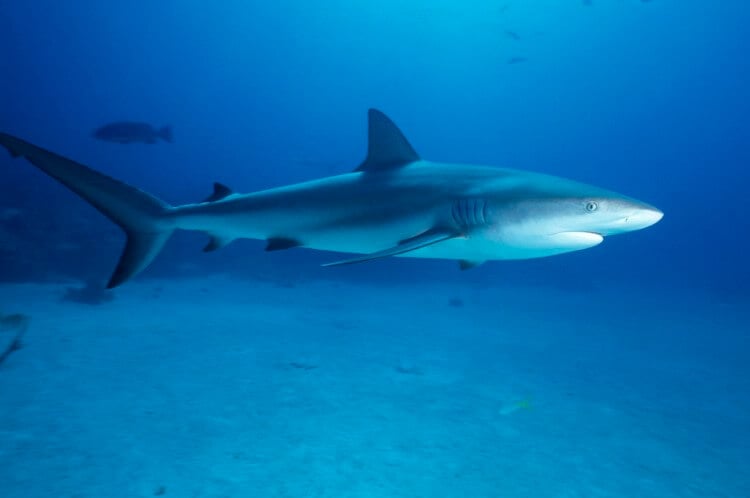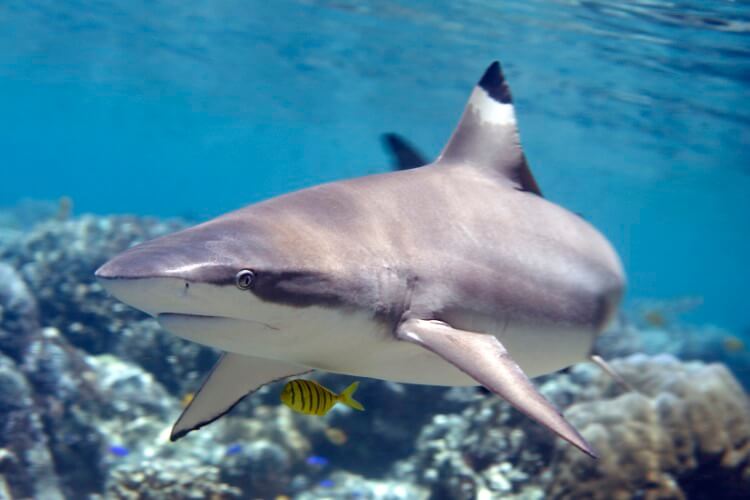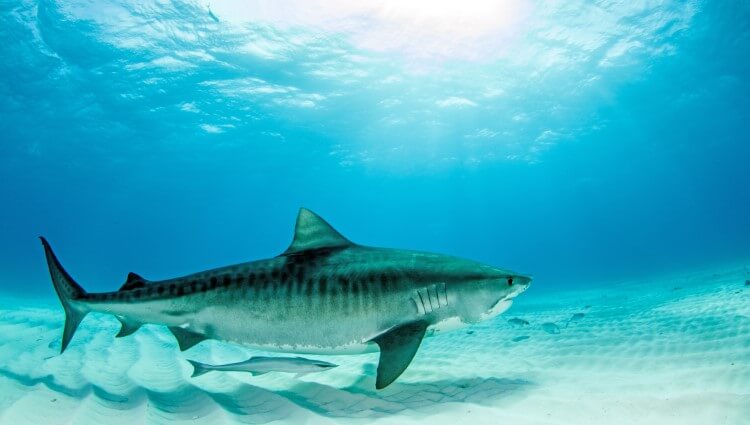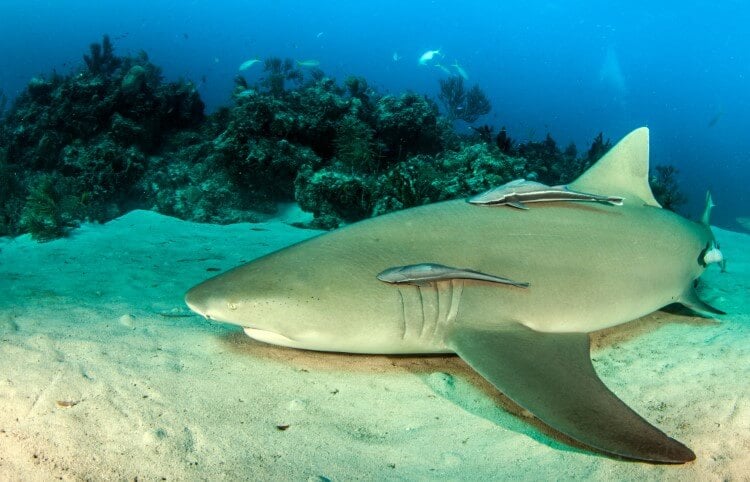Looking to spot some sharks in the Caribbean? From nurse sharks to bull sharks, our casual guide gives information on some stand-out species and details on how to see and behave around these impressive creatures.
Sharks are an amazing part of the Caribbean ecosystem. The abundant reefs and coral around each island attract a fantastic variety of marine life, from fish and crustaceans, to turtles and dolphins. The apex predators of these waters are, of course, our toothy (or sometimes toothless) friends. Whether it’s fierce, stocky-looking tiger sharks or mellow, wide-mouthed whale sharks, the Caribbean Sea and West Atlantic are home to over 25 wonderful species of shark.
For shark fans looking to stay, our award-winning collection of luxury Caribbean villas promise carefree access to the many boating and diving trips on offer, as well as private charters and family-friendly sea safaris.
What type of sharks live in the Caribbean?
Some of the most common and notable sharks in the Caribbean include reef sharks, nurse sharks, bull sharks, tiger sharks, lemon sharks and hammerheads, whale sharks. To list every species and genetic variation would be a tremendous undertaking, and one best suited to a scientific study. Even still, we still have a lot to learn about these fabulous creatures. The Caribbean reef shark and nurse sharks can be found almost anywhere in the Caribbean, even in less populated areas like St Lucia. Whereas some fan favorites such as hammerhead and whale sharks are very few in number and can only be found in certain areas. There are also many species of ray (close relatives of the shark) such as the giant manta ray.
6 amazing sharks in the Caribbean
Collected below are some shark celebrities, sharks that are well-loved by shark fans or are a common sight when scuba diving in the Caribbean.

Caribbean reef shark
The most common shark inhabitant of the reefs is the Caribbean reef shark. Which is not to say it’s the least interesting. The species can be found in the warm waters of the Atlantic Ocean between the U.S. and South America. Although it bears the sleek gray body of larger sharks of the same kind, this shark is known by its dusky coloration on its fins. They also have rather short pointed snouts which give it a streamlined appearance.
How big are Caribbean reef sharks?
Caribbean reef sharks are heavy-bodied sharks which can grow between 6.5 up to 10 feet long.
Are Caribbean reef sharks dangerous?
No, Caribbean reef sharks aren’t typically aggressive and won’t attack unless provoked, unless you’re an unlucky fish. They can, in fact, be quite shy.
What do Caribbean reef sharks eat?
Staying close to the reef, Caribbean reef sharks feed on small bony fish, cephalopods and the occasional ray.

Blacktip shark
Almost masquerading as the Caribbean reef shark, Blacktip sharks are a close relation.The noticeable difference between the two species is that blacktip sharks (unsurprisingly) have dark, black tips at the edge of fins. This species is not to be confused with the Blacktip reef shark which lives in the Indian and Pacific oceans.
Are blacktip sharks dangerous?
No, blacktip sharks tend to be wary of humans but may become aggressive in the presence of food.
Where do blacktip sharks live?
The distribution of blacktip sharks is all over the world. However, the species found in the Caribbean is genetically distinct from others.
How big do blacktip sharks get?
The average size for an adult blacktip is around 5 feet long, but the species can grow up to a maximum of 8 feet.

Nurse shark
Nurse sharks are the docile, friendly puppies of the shark world. They tend to mind their own business as they drift around the ocean floor near coastal areas. The species is distinct looking, with two rounded dorsal fins and a wide head. They tend to be brownish in color and have noticeable barbells at the sides of their mouth. Nurse sharks are coastal, bottom-dwelling creatures which tend to be dormant during the day. Ultimately, nurse sharks are the equivalent of that sleepy, relaxed person in your friend group.
Are nurse sharks dangerous?
No, nurse sharks only attack humans when provoked. However, it is commonly involved in reported attacks due to careless divers pulling its tail.
Do nurse sharks have teeth?
Yes, nurse sharks have very small, fine teeth
What do nurse sharks eat?
Nurse sharks prey on small fish, rays as well as crustaceans and molluscs.

Tiger shark
As the second largest predatory shark, behind the great white, tiger sharks should not be underestimated. The species can be found, with its blue-green, tiger-striped appearance, in warm and tropical waters around the world. It has large, pronounced teeth with a sideways pointing edge for slicing through hard shells and flesh. It’s one of the more intimidating sharks in the Caribbean and divers should be careful not to get on its bad side (the side with teeth).
Are tiger sharks dangerous?
Tiger sharks are considered one of the more aggressive shark species, alongside great white sharks and bull sharks. However most shark attacks are a case of mistaken identity. Regardless, it’s best to give this species some space.
What do tiger sharks eat?
Tiger sharks are known to eat almost anything, including occasional garbage. The food they eat ranges from fish, crustaceans, seals, birds, dolphins and sometimes other sharks.
How big is a tiger shark?
Adult tiger sharks typically range from 10 to13 feet long and the largest females can attain over 16 feet in length.

Great hammerhead shark
Who doesn’t love hammerheads, with a blunt, wide-faced appearance? The great hammerhead is the largest species of hammerhead shark. Apart from its size, the great hammerhead is distinct from other hammerheads because it has a wide, flat-edged cephalofoil (the “hammer”), perfect for some DIY.
How many great hammerhead sharks are left?
Some research suggests that there are less than 200 great hammerhead sharks left.
Where are great hammerhead sharks found?
Great hammerheads typically inhabit tropical oceanic waters around the world. Some great hammerhead sharks in the Cayman Islands have been seen off the coast of Grand Cayman near the underwater cliff known as the North Wall.
How big is a great hammerhead shark?
Great hammerheads typically measure between 11 and 15 feet long, although the largest ever recorded specimen was around 20 feet in length.

Whale shark
Oh, to be a whale shark! Aimlessly wandering the great blue yonder in search of more food. Among several other glittering accolades, whale sharks are famous for being the largest sharks.They are also the largest fish, the largest non-mammal vertebrate and largest animal besides whales – so, just a few gold medals. Whale sharks are distinct with white spots across their skin and large filter-mouths at the front of their heads. They are slow-moving, surface dwellers and travel great distances across the tropics to consume large amounts of food.
What do whale sharks eat?
Whale sharks are filter-feeders which consume krill, plankton and small fish.
How big are whale sharks?
Male whale sharks tend to be around 26 to 30 feet long, whereas females grow, on average, up to 48 feet in length. It is possible for whale sharks to grow up to 60 feet.
Is a whale shark a whale or a shark?
Whale sharks are fish, not mammals, and therefore are a type of shark. They are called whale sharks due to their large size and filter-feeding method
Sharks in Aruba
Aruba is a great place to go for some successful shark spotting.
The most common sharks in Aruba are reef sharks, whale sharks and hammerhead sharks.
Not surprisingly, reef sharks stay close to the coral reefs around Aruba, as do whale sharks. Whale sharks are also known to swim near the shore and into lagoons. Hammerhead sharks swim near continental shelves near the coast.
Hammerhead sharks and reef sharks are nocturnal predators and tend to be more active at night. During the day, some hammerhead species swim in schools and reef sharks find reef caves to rest in. Whale sharks swim in deeper waters during the day and return to the shallows at night.

Sharks in Jamaica
Although the inspiration for Ian Fleming’s James Bond novels, Jamaica is home to a different kind of Jaws.
The most common shark in Jamaica is the nurse shark, but tiger sharks, bull sharks and hammerheads have also been spotted.
Nurse sharks are docile and tend to stay close to the bottom of the ocean near the shore. They won’t attack unless provoked. Tiger sharks and bull sharks, however, are known to be two of the most aggressive species so ample respect needs to be paid to these sharks. Tiger sharks are generally found in deeper water but bull sharks prefer the shallows and, unlike most sharks, can even live in freshwater lakes and rivers. Hammerheads can also be found near reefs around the island.
Nurse sharks, tiger sharks, bull sharks and great hammerheads are all nocturnal animals, however bull sharks hunt in the day also.

Sharks in Turks and Caicos
Turks and Caicos has some awesome reefs and therefore awesome shark sightings too. The archipelago has many reefs and coral gardens off its coast and large wetlands. Among these areas there are gray reef sharks, sandy-colored lemon sharks and peaceful nurse sharks. Considering that millions visit the islands each year, there have only ever been three recorded shark attacks in the area, illustrating once and for all the misrepresentation of sharks as vicious killers.
These three nocturnal species are medium size sharks. As previously mentioned, nurse sharks are typically unaggressive and this is much the same for lemon and gray reef sharks. These sharks are likely to stick close to the reefs around the archipelago and occasionally swim into lagoons.
If you’re taking a trip to St Lucia hoping to see some large toothy fish, you may be disappointed. Sharks aren’t common off the coast of the island which isn’t to say you won’t see one, but it is very unlikely. If you do catch a glimpse, it’s likely to be a nurse shark which is a common species across the Caribbean.
Shark attacks in the Caribbean
Sharks tend to have a bad reputation for attacking humans. This is a little unfair as, in a vast majority of cases, sharks do not attack unless provoked. Even in the cases of more aggressive sharks, such as bull sharks or tiger sharks, these animals would prefer typical prey over a succulent human meal.
In the entire Caribbean Antilles region (which includes most of the central Caribbean islands), there have only been less than 50 recorded shark attacks in the last 270 years.
If you’re worried about sharks on your Caribbean getaway, there’s almost nothing to worry about. There is an extremely low chance of being a shark’s next meal.

Swimming with sharks in the Caribbean
Swimming with these intriguing creatures has become an increasingly popular activity in recent years. A favorite activity with travelers is swimming with whale sharks, due to their harmless nature and impressive size. When diving or taking a boat tour to see them, it’s important to remember to give these animals sufficient space and respect. Even the most harmless sharks can become scared or agitated, which leads to a shark attack. For example, peaceful nurse sharks can bite their own tails, so anyone pulling on their tail has provoked a bad time for both parties involved, human and fish. The golden rule: do not provoke a shark.
When selecting a particular vendor or tour operator it’s important to choose an established business that places the animals first and entertainment second. Be careful to avoid any companies that bait the waters to encourage sharks. This not only makes seeing them a manufactured experience, rather than observing them naturally, but sharks can be more aggressive when feeding. A reputable company will keep an appropriate distance from the sharks and will have on hand experts and naturalists who know detailed information and local knowledge about each species.
The same logic should be applied when shopping for souvenirs, to avoid shark tooth necklaces and other aquatic paraphernalia, such as starfish. Selling these items has a direct impact on the sharks and their habitat.
Sharks are magnificent creatures, and it’s important to observe them for study and for appreciation of them as animals. Shark experiences build respect for these creatures, but only if the operators also follow that same respect. There are many wonderful species of shark throughout the Caribbean and, depending on what sharks you want to see, you may want to select your destination based on the shark (especially avid shark fans).
Ready to visit the Caribbean? Top Villas has a range of luxury villas with a view of the Caribbean Sea.




